Read. Imagine. Travel.
We are achieving new milestones in the vaccination drive with each passing day as yesterday India broke its own record by administering over 10 million doses in a single day. With the ongoing inoculation drive on a massive scale and easing of travel advisories by countries such as UK, USA etc. for travel from / to India, we hope that we will soon be able to see the opening of our borders as well.
The arts and crafts of any country speak a lot about its rich culture and past traditions. From time immemorial, art has been a medium to express emotions, thoughts, and ideas. Some artists used clothes and walls to paint their expressions or depicting the story they wanted to tell. While others carved huge sculptures out of stones and wood or made wonders with the clay.

Nepal, which is well known as a Trekker’s paradise has also been blessed with skilled artisans who enriched this beautiful country situated amidst the Himalayas, with their creativity. Enjoy visuals of some of the indigenous craftwork from different parts of Nepal.
The art and craft of Nepal is not new to the world. A renowned name in art, Araniko, who is known for building Beijing’s famous white Stupa at the Miaoying Temple was born in Nepal. To create history, at just the age of 17 years, the 12th century-born Araniko volunteered to lead a team of 80 artisans to Tibet and then eventually on to China.
Fun Fact: Araniko made a big name in China, as he was the one who introduced Pagoda style of architecture in China for the first time. But do you know that 06th century Changu Narayan Temple (in Bhaktapur), an architectural marvel and still a milestone in Nepali temple architecture with rich embossed works, was built even before he was born?
Let us take you to explore the craftsmanship of the country whose art had made a name in the subcontinent even before Araniko, who further spread it and became a famous figure in China and Tibet.
ARCHITECTURAL SKILLS
Nepal, even today, is nothing less than a canvas to tastefully crafted temples, squares, and palaces. The religious influence on the art is clearly evident by the pagodas, stupas and temples belonging to Hinduism and Buddhism built everywhere around palaces, riverbanks, wells, squares, etc. Much of the credit for preserving the beautiful architecture goes to Nepal’s indigenous tribe of Newars and their most common styles are Stupa, Shikhara, and Pagoda. Some of the interesting masterpieces that are worth seeing are the 16th-century Kasthamandapa Temple, which was considered among the oldest wooden structures in the world. We are sure one would not be able to hold himself / herself to see this masterpiece when told that not even a single nail had been used to build this three-storied structure. Unfortunately, the 2015 earthquake snatched this wonder of art and today one can admire this beautiful creation in photographs only. Durbar squares in each of the cities (Kathmandu, Bhaktapur, and Patan) are a treasure-trove of art work and an art enthusiast would love to spend hours admiring the craftsmanship.
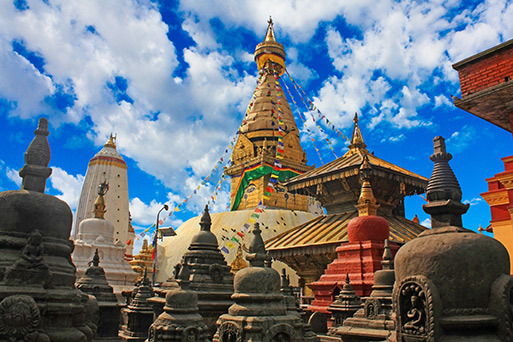
One can visit Patan Durbar square for Shikhara-styled architecture, Pashupatinath and Changu Narayan temple for pagoda styled architecture and Boudhnath, Swaymbhunath, and Namo Buddha for the Stupa Style. In fact, Swaymbhunath Temple is the most common choice of cover page photos for Nepal.
INSIDER TIP: One can find Newari Settlements in and around Changu Narayan Temple. So, while going towards the temple, one also gets to see the lifestyle of the community behind the architecture skills.
These architectural marvels are not just a structure of brick and wood but a canvas for different artisans. While few created wonders in different styled structures made out of Brick and wood, the others made sure to carve their imagination on every inch of the wood and stone used in these structures. The craftsmanship in these architectures by different artisans will leave you speechless whether it’s a wood carving or stone carving.
|
WOOD CARVING
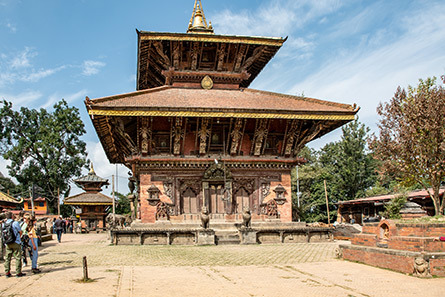 Let us take you again to Changu Narayan temple where the wooden struts supporting the roofs of the Temple were beautifully carved with ten incarnations of Lord Vishnu and other idols. One of the finest woodworks can be seen in Kathmandu Durbar Square (also called Basantpur) especially the inner courtyard of Kumari house. Another highlight of this artwork can be seen in Bhaktapur where the most admirable woodwork among the several carved doors and windows is that of the peacock window and former Royal palace’s 55 windows. The most common themes chosen by woodcarvers were of hinduistic and buddhistic gods, scenes from day-to-day life of natives, animals, birds, and erotic images of humans and animals. Patan is another place where admirers can find some more wood carvings.
Let us take you again to Changu Narayan temple where the wooden struts supporting the roofs of the Temple were beautifully carved with ten incarnations of Lord Vishnu and other idols. One of the finest woodworks can be seen in Kathmandu Durbar Square (also called Basantpur) especially the inner courtyard of Kumari house. Another highlight of this artwork can be seen in Bhaktapur where the most admirable woodwork among the several carved doors and windows is that of the peacock window and former Royal palace’s 55 windows. The most common themes chosen by woodcarvers were of hinduistic and buddhistic gods, scenes from day-to-day life of natives, animals, birds, and erotic images of humans and animals. Patan is another place where admirers can find some more wood carvings.
And the art is not just limited to historical monuments and palaces only, but also can be seen on the doors, windows, and pillars alongside the streets on which stories were carved. Many of the portable masterpieces have been preserved in museums as well.
As aforementioned, this centuries-old art has been passed from generation to generation, one can find much of the stuff replica of ancient designs and that makes a perfect souvenir too. The local markets are flooded with lots of wood-carved frames and figurines, which one can take along with.
STONE SCULPTURES
 These also contributed a lot to the richness of the architectures found here and the traces of this art are believed to be even earlier than the period of Christ. Sculptures carved in different periods (Kirat, Licchhavi, Thakuri, and Malla Period) can easily be noticed due to the distinction in their styles and materials used. Some of the artworks which one should not miss are Virupaksya and Parvati Tapasya sculptures at Pashupatinath Temple dating back to Kirat Period before 5th Century B.C, Garuda Narayan at Changu Narayan, Narsimha Image at Kathmandu Durbar Square, and several religious idols in Patan and Bhaktapur.
These also contributed a lot to the richness of the architectures found here and the traces of this art are believed to be even earlier than the period of Christ. Sculptures carved in different periods (Kirat, Licchhavi, Thakuri, and Malla Period) can easily be noticed due to the distinction in their styles and materials used. Some of the artworks which one should not miss are Virupaksya and Parvati Tapasya sculptures at Pashupatinath Temple dating back to Kirat Period before 5th Century B.C, Garuda Narayan at Changu Narayan, Narsimha Image at Kathmandu Durbar Square, and several religious idols in Patan and Bhaktapur.
Stone art is believed to be the oldest of all the art forms developed in Nepal. Chowks and Durbar squares in Patan and Kathmandu have many masterpieces in abundance. To name a few are 2200 years old statue of Gaja Lakshmi and around 3500-year-old Deepawati Mahabir’s statue in Patan, statues dating back to 5th century AD at Changu Narayan Temple, and idols at Pashupatinath which are also believed to be of 6th century B.C.
One will also admire the sculpture work at Nyatapola temple in Bhaktapur. Here one can see the giant statues on both sides of the steps leading to the five-storied temple, which was built around the time when the famous Taj Mahal (Agra, India) was under construction.
Another unique art can be seen at Budhanikantha Temple (Kathmandu), where one can see Lord Vishnu in a reclining position. The statue in the middle of the pool, which is carved out of a single black basalt block is considered to be the largest of all stone carvings in Nepal.
FUN FACT: The Oldest believed sculpture of Nepal is of Baman Tribikram, which was erected in the Licchavi period (400-750AD).
BRONZE FIGURES
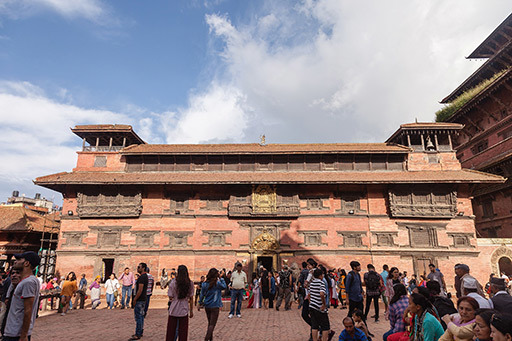
The art of idols and sculpture-making didn’t confine to Stones only. Bronze casting was also a popular art in those times to make religious figurines and it is still continuing. Patan, which is believed to be the birthplace of Araniko is the best place to see the finest bronze casting. What started with the casting of coins and decorative figurines progressed with religious sculptures of Hinduism and Buddhism sects.
We can also take you to the artisans’ workshop to show the entire process of making these statues using the lost wax technique. These could be the best souvenir to take along with to keep the memories of the culturally rich tour alive forever. To see more of the bronze artwork, one can visit Patan Museum.
PAINTING
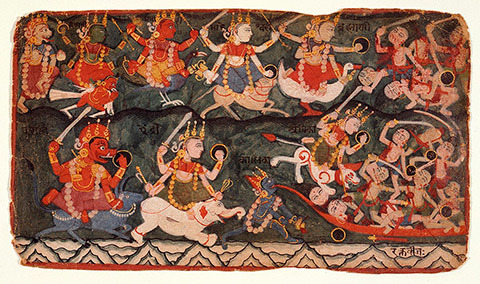
Nepalese paintings are more of religious paintings canvassed on large clothes or walls and are termed as Paubhas. Mostly done by the Newar community, the craftsmanship of these painters was famous throughout Asia and even one of their styles, BERI, became universal in Tibet.
Such was the influence of their craftsmanship that many times, they were called for special projects in China and Tibet. By the 1900s, the art evolved and made way for western styles as well.
FUN FACT: The well-known Newari artist Araniko, who chiseled his name in the history for architecting many historic temples and structures was also a painter and bronze sculptor.
POTTERY
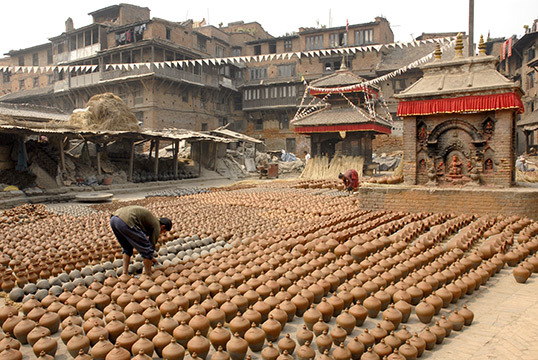
Pottery is another craft which is very popular in Nepal from time immemorial and the fact is proven by the pottery specimens belonging to the period of Buddha, found in Lumbini. Traditionally, it has been widely used in the Newar community for several kinds of wares. The terracotta oil lamps are still very popular and in-demand during the festivals. We will not go into the nitty-gritty of their making process, as it's quite common but we would like to tell you that there is a dedicated Pottery Square in Bhaktapur, which had been a clay vessel site for ages. The whole area is picturesque with many potter wheels and several clay creations in the making. The square is surrounded by shops selling finished clay products.
Bhaktapur and Thimi are the places for you if you like pottery crafts. You will find around 300 potter families in Thimi and somewhere around 100 in Bhaktapur, who are traditionally continuing the legacy passed on from generation to generation.
In a nutshell, Nepal is home to traditional art and crafts that are both versatile and aesthetically enticing and will make you fall in love with them instantly. These unforgettable impressions will surely be etched into your memory forever. At Indo Asia Tours, all the trips are curated mindfully to explore the charisma of bold, vibrant, and detailed spectacle of different crafts and artworks.
FUN FACT: Deraniyagala's finding indicated that the people who lived in Batadombalena used geometric microliths around 31,000 years ago, which was many millennia earlier than in Europe.
|
Virtual Destination Training Program
|
 We can conduct a virtual destination awareness training program for your team or yourself or a virtual tour for your clients. Let us know the destination of your interest along with your convenient date / time and we will be happy to set up a program for you.
We can conduct a virtual destination awareness training program for your team or yourself or a virtual tour for your clients. Let us know the destination of your interest along with your convenient date / time and we will be happy to set up a program for you.
Send Request
|
Please feel free to write back to us at marketing@indoasiatours.com to share our thoughts on customized journeys covering the Indian subcontinent or take time to visit our website https://www.indoasia-tours.com. Be sure we will prepare the best program to make a memorable trip for your esteemed clients!
|
|


 One can visit Patan Durbar square for Shikhara-styled architecture, Pashupatinath and Changu Narayan temple for pagoda styled architecture and Boudhnath, Swaymbhunath, and Namo Buddha for the Stupa Style. In fact, Swaymbhunath Temple is the most common choice of cover page photos for Nepal.
One can visit Patan Durbar square for Shikhara-styled architecture, Pashupatinath and Changu Narayan temple for pagoda styled architecture and Boudhnath, Swaymbhunath, and Namo Buddha for the Stupa Style. In fact, Swaymbhunath Temple is the most common choice of cover page photos for Nepal.
 Let us take you again to Changu Narayan temple where the wooden struts supporting the roofs of the Temple were beautifully carved with ten incarnations of Lord Vishnu and other idols. One of the finest woodworks can be seen in Kathmandu Durbar Square (also called Basantpur) especially the inner courtyard of Kumari house. Another highlight of this artwork can be seen in Bhaktapur where the most admirable woodwork among the several carved doors and windows is that of the peacock window and former Royal palace’s 55 windows. The most common themes chosen by woodcarvers were of hinduistic and buddhistic gods, scenes from day-to-day life of natives, animals, birds, and erotic images of humans and animals. Patan is another place where admirers can find some more wood carvings.
Let us take you again to Changu Narayan temple where the wooden struts supporting the roofs of the Temple were beautifully carved with ten incarnations of Lord Vishnu and other idols. One of the finest woodworks can be seen in Kathmandu Durbar Square (also called Basantpur) especially the inner courtyard of Kumari house. Another highlight of this artwork can be seen in Bhaktapur where the most admirable woodwork among the several carved doors and windows is that of the peacock window and former Royal palace’s 55 windows. The most common themes chosen by woodcarvers were of hinduistic and buddhistic gods, scenes from day-to-day life of natives, animals, birds, and erotic images of humans and animals. Patan is another place where admirers can find some more wood carvings.
 These also contributed a lot to the richness of the architectures found here and the traces of this art are believed to be even earlier than the period of Christ. Sculptures carved in different periods (Kirat, Licchhavi, Thakuri, and Malla Period) can easily be noticed due to the distinction in their styles and materials used. Some of the artworks which one should not miss are Virupaksya and Parvati Tapasya sculptures at Pashupatinath Temple dating back to Kirat Period before 5th Century B.C, Garuda Narayan at Changu Narayan, Narsimha Image at Kathmandu Durbar Square, and several religious idols in Patan and Bhaktapur.
These also contributed a lot to the richness of the architectures found here and the traces of this art are believed to be even earlier than the period of Christ. Sculptures carved in different periods (Kirat, Licchhavi, Thakuri, and Malla Period) can easily be noticed due to the distinction in their styles and materials used. Some of the artworks which one should not miss are Virupaksya and Parvati Tapasya sculptures at Pashupatinath Temple dating back to Kirat Period before 5th Century B.C, Garuda Narayan at Changu Narayan, Narsimha Image at Kathmandu Durbar Square, and several religious idols in Patan and Bhaktapur.
 The art of idols and sculpture-making didn’t confine to Stones only. Bronze casting was also a popular art in those times to make religious figurines and it is still continuing. Patan, which is believed to be the birthplace of Araniko is the best place to see the finest bronze casting. What started with the casting of coins and decorative figurines progressed with religious sculptures of Hinduism and Buddhism sects.
The art of idols and sculpture-making didn’t confine to Stones only. Bronze casting was also a popular art in those times to make religious figurines and it is still continuing. Patan, which is believed to be the birthplace of Araniko is the best place to see the finest bronze casting. What started with the casting of coins and decorative figurines progressed with religious sculptures of Hinduism and Buddhism sects.
 Nepalese paintings are more of religious paintings canvassed on large clothes or walls and are termed as Paubhas. Mostly done by the Newar community, the craftsmanship of these painters was famous throughout Asia and even one of their styles, BERI, became universal in Tibet.
Nepalese paintings are more of religious paintings canvassed on large clothes or walls and are termed as Paubhas. Mostly done by the Newar community, the craftsmanship of these painters was famous throughout Asia and even one of their styles, BERI, became universal in Tibet.
 Pottery is another craft which is very popular in Nepal from time immemorial and the fact is proven by the pottery specimens belonging to the period of Buddha, found in Lumbini. Traditionally, it has been widely used in the Newar community for several kinds of wares. The terracotta oil lamps are still very popular and in-demand during the festivals. We will not go into the nitty-gritty of their making process, as it's quite common but we would like to tell you that there is a dedicated Pottery Square in Bhaktapur, which had been a clay vessel site for ages. The whole area is picturesque with many potter wheels and several clay creations in the making. The square is surrounded by shops selling finished clay products.
Pottery is another craft which is very popular in Nepal from time immemorial and the fact is proven by the pottery specimens belonging to the period of Buddha, found in Lumbini. Traditionally, it has been widely used in the Newar community for several kinds of wares. The terracotta oil lamps are still very popular and in-demand during the festivals. We will not go into the nitty-gritty of their making process, as it's quite common but we would like to tell you that there is a dedicated Pottery Square in Bhaktapur, which had been a clay vessel site for ages. The whole area is picturesque with many potter wheels and several clay creations in the making. The square is surrounded by shops selling finished clay products.
 We can conduct a virtual destination awareness training program for your team or yourself or a virtual tour for your clients. Let us know the destination of your interest along with your convenient date / time and we will be happy to set up a program for you.
We can conduct a virtual destination awareness training program for your team or yourself or a virtual tour for your clients. Let us know the destination of your interest along with your convenient date / time and we will be happy to set up a program for you.

